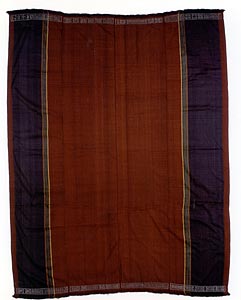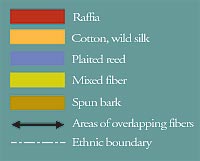
As early as the 16th century, the Malagasy used cotton
for clothing and endowed it with sacred healing properties. Newly spun cotton was called "living yarn," and healers used it to make protective charms for personal
and ritual use.
Cotton was so plentiful in the arid southwest that it clothed almost all members of society. Tandroy, Mahafale, Bara and Sakalava weavers wove it into broad waist and shoulder wrappers for both women and men and into long, narrow loincloths for men. Both cotton and silk
cloth were frequently embellished with beadwork or twining at either end of the weft (the horizontal threads interlaced through a fabric's warp), thus increasing their value and beauty.

 Women
were responsible for making the hand-spun cotton thread. They painstakingly
dried and cleaned the cotton bolls, removed the seeds by hand, gently
stretched them into bands and spun them with a hand-turned spindle. Today,
cotton is still grown in southwest Madagascar and spun into threads for
use by weavers and commercial factories, the latter supplying cotton fabrics
for Madagascar's growing export clothing industry. Women
were responsible for making the hand-spun cotton thread. They painstakingly
dried and cleaned the cotton bolls, removed the seeds by hand, gently
stretched them into bands and spun them with a hand-turned spindle. Today,
cotton is still grown in southwest Madagascar and spun into threads for
use by weavers and commercial factories, the latter supplying cotton fabrics
for Madagascar's growing export clothing industry.

 The
most valuable textile fiber for the Malagasy is made from an indigenous,
or wild, silkworm (Borocera madagascarensis) found throughout much
of the western half of the island. The silkworms feed and spin their cocoons
in the leaves of a variety of forest trees that determine the color the
fiber takes, ranging from a creamy white to a light brown. Women harvest
the cocoons, prepare the fiber and weave the cloth. The
most valuable textile fiber for the Malagasy is made from an indigenous,
or wild, silkworm (Borocera madagascarensis) found throughout much
of the western half of the island. The silkworms feed and spin their cocoons
in the leaves of a variety of forest trees that determine the color the
fiber takes, ranging from a creamy white to a light brown. Women harvest
the cocoons, prepare the fiber and weave the cloth.
The Malagasy value this silk, as well as domesticated mulberry silk,
for its natural durability, sheen and warmth. But silk also carries many sacred connotations, making silk textiles the choice in the 19th century, especially in the highlands region, to clothe Malagasy rulers and their royal objects. It was also used--as it is today--to wrap the deceased for burial.
|

|
Wrapper (lambamena)
Betsileo peoples, Madagascar
Late 19th century
Wild silk, dye
National Museum of Natural History, Smithsonian Institution, 378,458
Lambamena is a predominately red textile, with two wide black stripes edged by narrow stripes in yellow and/or green; sometimes the border is decorated with metal
or glass beads.

|
|

 As
with other natural fibers, silk processing is a labor-intensive process
performed by Malagasy women. The wild silk cocoons are
As
with other natural fibers, silk processing is a labor-intensive process
performed by Malagasy women. The wild silk cocoons are
- gathered in the forest;
- cleaned of debris, including the coating of sharp spines;
- boiled to remove the gum;
- softened by rubbing;
- stretched into long bands;
- thinned into thread by rolling it on the thigh.
What happens to the silkworm? Usually, by
the time people collect the wild silk cocoons,
the worms have already metamorphosed into moths and burst out of the cocoons. In contrast, domesticated mulberry silk cocoons are sometimes steamed to kill the worm inside and thus preserve
the precious single silk thread as the worm spun it.

Silk cocoons and strands of wild silk, domesticated
mulberry silk, cotton, raffia and bark are used in Madagascar to produce handwoven textiles.
Pictured above (from top to bottom)
Bara women wearing plain and striped cotton wrappers and men wearing cotton shoulder wraps and loincloths
Photographer unknown, c. 1900
Collotype
Postcard Collection, MG-5-21
Eliot Elisofon Photographic Archives
National Museum of African Art, Smithsonian Institution
Silk cocoons for sale at a highlands market
Photographer unknown, c. 1900
Collotype
Postcard Collection, MG-16-6
Eliot Elisofon Photographic Archives
National Museum of African Art, Smithsonian Institution
Woman using a spindle to hand-spin silk thread in a technique that is still used today
Photographer unknown, c. 1900
Collotype
Postcard Collection, MG-4-7
Eliot Elisofon Photographic Archives
National Museum of African Art, Smithsonian Institution
|

|
|
|
